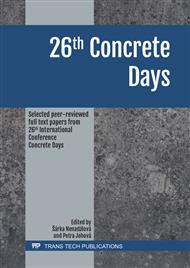[1]
ČSN EN 14845-2: Test methods for fibres in concrete - Part 2: Effect on concrete. ČNI (2007).
Google Scholar
[2]
Vítek, P., Staňková Z., Fibre reinforced concrete for tunnel structures [in Czech], in: 21st Concrete Days 2014, Pardubice, ČBS, (2014).
Google Scholar
[3]
Tipka, M., Vašková, J., Vodička, J., Tensile strength tests for concrete and fibre reinforced concrete, in: 24th Concrete Days 2017, Zurich: Trans Tech Publications, (2018).
DOI: 10.4028/www.scientific.net/ssp.272.94
Google Scholar
[4]
Pukl, R., Lehký, D., Lipowczan, M., Novák, D., Material parameters for computer analysis of fibre reinforced concrete structures, in: 10th International Conference Fibre Concrete 2019, Prague, CTU in Prague, (2019).
DOI: 10.1088/1757-899x/596/1/012008
Google Scholar
[5]
Tipka, M., Tensile Properties of Structural Fibre Reinforced Concrete [in Czech], Ph.D. Thesis, CTU in Prague, Faculty of Civil Engineering, Prague, (2017).
Google Scholar
[6]
Tlemat, H., Pilakoutas, K., Neocleous, K., Modelling of SFRC using inverse finite element analysis, in: Materials and Structures 39, (2006).
DOI: 10.1617/s11527-005-9010-y
Google Scholar
[7]
Abbas, A.A., Syed Mohsin, S.M., Cotsovos, D.M., A simplified finite element model for assessing steel fibre reinforced concrete structural performance, in: Computers and Structures 173, (2016).
DOI: 10.1016/j.compstruc.2016.05.017
Google Scholar
[8]
Amin, A., Foster, S.J., Numerical modelling of large scale steel fibre reinforced - reinforced concrete beams failing in shear, in: FRC 2014 Joint ACI-fib International Workshop Fibre Reinforced Concrete: from Design to Structural Applications, (2014).
DOI: 10.35789/fib.bull.0079.ch16
Google Scholar
[9]
Zhan, Y., Bui, H.-G., Ninic, J., Mohseni, S.A., Meschke, G., Numerical modeling of steel fiber reinforced concrete on the meso- and macro-scale, in: Computational Modelling of Concrete Structures - Proceedings of EURO-C 2014, (2014).
DOI: 10.1201/b16645-64
Google Scholar
[10]
Buljak V., Oesch T., Bruno G., Simulating Fiber-reinforced concrete mechanical performance using CT-based fiber orientation data, in: Materials (Basel) 2019;12(5), (2019).
DOI: 10.3390/ma12050717
Google Scholar


